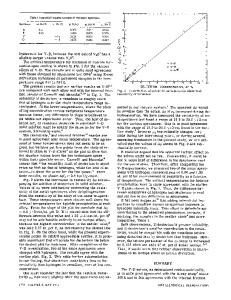Isotope Effect on the Electronic Structure of Hydrogen in Metals
- PDF / 805,753 Bytes
- 6 Pages / 412.2 x 631.8 pts Page_size
- 5 Downloads / 375 Views
547
ISOTOPE EFFECT ON THE ELECTRONIC STRUCTURE OF HYDROGEN IN METALS
P. JENA AND C. B. SATTERTHWAITE Physics Department, Virginia Commonwealth University,
Richmond, VA
23284
ABSTRACT The effect of the isotopic mass on the redistribution of electron charge and spin density around a light impurity such as hydrogen in metals has been studied. Considered in this review are: (a) the magnetic hyperfine coupling to the hydrogen nucleus and the effect of isotopic mass, (b) the isotope effect in hydrogen impurity resistivity, (c) the reverse isotope effect in superconducting PdH(D) and (d) the thermally induced detrapping of hydrogen from the vicinity of solute sites in metallic hosts.
The technological importance of the study of hydrogen in metals such as hydrogen storage, hydrogen embrittlement, and hydrogen-induced blistering has stimulated many theoretical and experimental investigations in recent years. 1 Considerable attention has been given to a fundamental understanding of the metalhydrogen interaction and the nature of induced electron distribution around this light impurity. In this paper we focus our attention on a rather novel aspect of the metal-hydrogen interaction--the quantum nature of the solute. The large amplitude of the zero-point vibration of hydrogen and helium in their condensed phase is known to give rise to quantum effects and the success of the quantum 2 theory of solids in accounting for experimental observations is well documented. Here, we emphasize the quantum effect of a light interstitial on the electronic environment of its host. Since the positive muon, the lightest isotope of hydrogen has a mass of 1/9 proton mass and triton is three times as heavy as a proton, it is clear that hydrogen and its isotopes are the best candidates for studying the quantum effects. We review the experimental situation regarding the nuclear spin-lattice relaxation rate, impurity resistivity, superconducting transition temperature and solute trapping of hydrogen as it pertains to the quantum-nature of hydrogen. A simple physical picture is provided to understand the experimental trend. Since the electrons respond to an external perturbation almost instantaneously compared to the time it takes the impurity such as hydrogen either to execute one complete vibration around its equilibrium site or to jump from one site to another, the response is assumed to be adiabatic. Thus the electrons of the host material are not supposed to be able to distinguish between the different isotopes of hydrogen. Such would be the case if the isotopes of hydrogen were vibrating in a region of space where the ambient charqe distribution is homogeneous. From inelastic neutron scattering experiments it can be deduced that the root mean square amplitude of hydrogen in most metals may be as large as 0.25R. Using harmonic expression, the corresponding root mean square amplitudes of the + lightest Cu) and heaviest (triton) isotopes of hydrogen are 0.43.R and 0.19R re4 spectively. It was first pointed out by Miller and Satterthwaite that
Data Loading...











